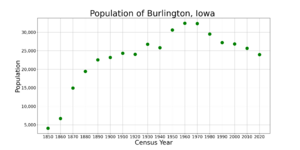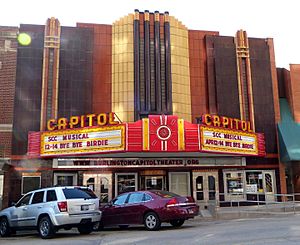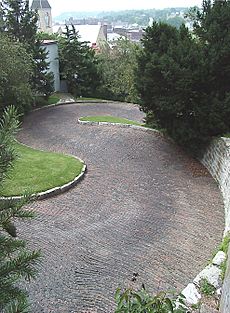Burlington, Iowa facts for kids
Quick facts for kids
Burlington, Iowa
Shoquoquon
Flint Hills
|
|
|---|---|
|
City
|
|
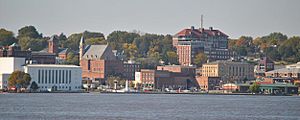
Downtown Burlington from Mississippi River
|
|
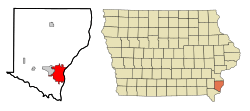
Location in the state of Iowa
|
|
| Country | United States |
| State | |
| County | Des Moines |
| Founded | 1833 |
| Named for | Burlington, Vermont |
| Government | |
| • Type | Mayor–council government |
| Area | |
| • Total | 15.17 sq mi (39.29 km2) |
| • Land | 14.41 sq mi (37.32 km2) |
| • Water | 0.76 sq mi (1.98 km2) |
| Elevation | 696 ft (185 m) |
| Population
(2020)
|
|
| • Total | 23,982 |
| • Density | 1,664.49/sq mi (642.68/km2) |
| • Demonym | Burlingtonian |
| Time zone | UTC−6 (CST) |
| • Summer (DST) | UTC−5 (CDT) |
| ZIP code |
52601
|
| Area code(s) | 319 |
| FIPS code | 19-09550 |
| GNIS feature ID | 0454995 |
Burlington is a city in Iowa, United States. It is the main city of Des Moines County. In 2020, about 23,982 people lived there. Burlington is famous for Snake Alley, which is known as one of the most winding streets in the world!
Contents
History of Burlington
Before Europeans settled here, the area was a special neutral zone. It was used by the Sac and Fox Native American tribes. They called it Shoquoquon, which means "Flint Hills."
In 1803, President Thomas Jefferson sent explorers to map the new Louisiana Purchase lands. Lt. Zebulon Pike explored the Mississippi River. In 1805, he landed near Burlington. He raised the United States Flag there for the first time on Iowa soil.
Settlement began in 1833, after the Black Hawk Purchase. Early settlers like Samuel White and Morton M. McCarver crossed the Mississippi River. They set up claims and built cabins.
In 1834, John Gray bought the first piece of land. He paid $50 to rename the town. He chose "Burlington" to honor his hometown in Vermont. His daughter, Abigail, was the first European-American child born in Iowa that same year.
In 1837, Burlington became the second capital of the Wisconsin Territory. Then, in 1838, it was named the first capital of the new Iowa Territory. The government met in "Old Zion," which was Iowa's first Methodist Church.
In 1849, Major William Williams visited Burlington. He wrote that the town was "beautifully elevated" and had "considerable business." He noted its "tasteful, brick dwellings" and "handsome residences." He also said the view from the river was "extremely picturesque."
Iowa's nickname, "The Hawkeye State," started in Burlington. A newspaper changed its name to The Hawk-Eye to honor Chief Black Hawk. This helped to remember the old chief.
Burlington was a busy river port during the steamboat era. It was also a key city for the Chicago, Burlington and Quincy Railroad. This railroad was known as the "Burlington Route." Today, the "Burlington" name is part of one of the biggest railroads in the United States, the BNSF Railway.
In 1970, Burlington had its largest population ever. Later in the 20th century, new shopping areas opened outside the city center. For example, Aldi opened its first U.S. store in Burlington in 1976. Westland Mall opened nearby in 1977.
Geography and Weather
Burlington covers about 15.24 square miles (39.5 square kilometers). Most of this area is land, with a small part being water.
Climate in Burlington
Burlington has a climate with warm summers and cold winters.
| Climate data for Burlington, Iowa (Southeast Iowa Regional Airport) 1991–2020 normals, extremes 1897–present | |||||||||||||
|---|---|---|---|---|---|---|---|---|---|---|---|---|---|
| Month | Jan | Feb | Mar | Apr | May | Jun | Jul | Aug | Sep | Oct | Nov | Dec | Year |
| Record high °F (°C) | 70 (21) |
76 (24) |
88 (31) |
93 (34) |
103 (39) |
105 (41) |
111 (44) |
110 (43) |
103 (39) |
95 (35) |
86 (30) |
73 (23) |
111 (44) |
| Mean maximum °F (°C) | 55.3 (12.9) |
59.9 (15.5) |
74.2 (23.4) |
82.6 (28.1) |
88.7 (31.5) |
93.1 (33.9) |
94.7 (34.8) |
94.6 (34.8) |
91.4 (33.0) |
84.3 (29.1) |
70.6 (21.4) |
59.3 (15.2) |
96.8 (36.0) |
| Mean daily maximum °F (°C) | 32.3 (0.2) |
37.2 (2.9) |
50.2 (10.1) |
62.8 (17.1) |
73.1 (22.8) |
82.3 (27.9) |
85.2 (29.6) |
83.5 (28.6) |
77.5 (25.3) |
64.5 (18.1) |
49.8 (9.9) |
37.4 (3.0) |
61.3 (16.3) |
| Daily mean °F (°C) | 24.3 (−4.3) |
28.8 (−1.8) |
40.7 (4.8) |
52.3 (11.3) |
63.0 (17.2) |
72.5 (22.5) |
75.6 (24.2) |
73.8 (23.2) |
66.7 (19.3) |
54.2 (12.3) |
41.0 (5.0) |
29.9 (−1.2) |
51.9 (11.0) |
| Mean daily minimum °F (°C) | 16.4 (−8.7) |
20.5 (−6.4) |
31.1 (−0.5) |
41.9 (5.5) |
52.9 (11.6) |
62.6 (17.0) |
66.0 (18.9) |
64.0 (17.8) |
55.8 (13.2) |
44.0 (6.7) |
32.3 (0.2) |
22.3 (−5.4) |
42.5 (5.8) |
| Mean minimum °F (°C) | −6.6 (−21.4) |
0.4 (−17.6) |
10.8 (−11.8) |
26.8 (−2.9) |
38.0 (3.3) |
50.4 (10.2) |
55.5 (13.1) |
53.6 (12.0) |
40.0 (4.4) |
27.6 (−2.4) |
15.1 (−9.4) |
0.9 (−17.3) |
−10.9 (−23.8) |
| Record low °F (°C) | −24 (−31) |
−27 (−33) |
−13 (−25) |
11 (−12) |
26 (−3) |
39 (4) |
46 (8) |
41 (5) |
23 (−5) |
10 (−12) |
−2 (−19) |
−22 (−30) |
−27 (−33) |
| Average precipitation inches (mm) | 1.45 (37) |
1.69 (43) |
2.43 (62) |
3.92 (100) |
4.93 (125) |
4.87 (124) |
4.02 (102) |
3.77 (96) |
3.53 (90) |
3.09 (78) |
2.29 (58) |
1.87 (47) |
37.86 (962) |
| Average snowfall inches (cm) | 6.7 (17) |
6.5 (17) |
1.9 (4.8) |
0.1 (0.25) |
0.0 (0.0) |
0.0 (0.0) |
0.0 (0.0) |
0.0 (0.0) |
0.0 (0.0) |
0.0 (0.0) |
0.8 (2.0) |
7.5 (19) |
23.5 (60.05) |
| Average precipitation days (≥ 0.01 in) | 8.0 | 8.2 | 9.9 | 11.8 | 13.2 | 11.4 | 9.8 | 9.1 | 7.5 | 9.3 | 8.0 | 7.5 | 113.7 |
| Average snowy days (≥ 0.1 in) | 4.7 | 5.1 | 1.8 | 0.1 | 0.0 | 0.0 | 0.0 | 0.0 | 0.0 | 0.0 | 1.3 | 4.5 | 17.5 |
| Source: NOAA | |||||||||||||
| Climate data for Burlington 2S, Iowa (1991–2020 normals, extremes 1964–present) | |||||||||||||
|---|---|---|---|---|---|---|---|---|---|---|---|---|---|
| Month | Jan | Feb | Mar | Apr | May | Jun | Jul | Aug | Sep | Oct | Nov | Dec | Year |
| Record high °F (°C) | 70 (21) |
74 (23) |
88 (31) |
92 (33) |
98 (37) |
104 (40) |
105 (41) |
105 (41) |
101 (38) |
93 (34) |
79 (26) |
74 (23) |
105 (41) |
| Mean maximum °F (°C) | 56.0 (13.3) |
60.4 (15.8) |
73.0 (22.8) |
81.1 (27.3) |
88.0 (31.1) |
92.6 (33.7) |
95.1 (35.1) |
94.5 (34.7) |
91.4 (33.0) |
83.9 (28.8) |
69.4 (20.8) |
58.7 (14.8) |
97.0 (36.1) |
| Mean daily maximum °F (°C) | 32.0 (0.0) |
37.1 (2.8) |
49.9 (9.9) |
62.3 (16.8) |
72.7 (22.6) |
81.8 (27.7) |
85.0 (29.4) |
83.4 (28.6) |
77.1 (25.1) |
64.5 (18.1) |
49.6 (9.8) |
36.9 (2.7) |
61.0 (16.1) |
| Daily mean °F (°C) | 23.5 (−4.7) |
28.1 (−2.2) |
39.7 (4.3) |
51.4 (10.8) |
62.3 (16.8) |
71.7 (22.1) |
75.3 (24.1) |
73.4 (23.0) |
66.2 (19.0) |
53.9 (12.2) |
40.3 (4.6) |
28.8 (−1.8) |
51.2 (10.7) |
| Mean daily minimum °F (°C) | 15.0 (−9.4) |
19.1 (−7.2) |
29.6 (−1.3) |
40.5 (4.7) |
51.9 (11.1) |
61.7 (16.5) |
65.6 (18.7) |
63.5 (17.5) |
55.2 (12.9) |
43.3 (6.3) |
31.0 (−0.6) |
20.7 (−6.3) |
41.4 (5.2) |
| Mean minimum °F (°C) | −6.0 (−21.1) |
−0.1 (−17.8) |
9.6 (−12.4) |
26.3 (−3.2) |
38.9 (3.8) |
50.3 (10.2) |
56.8 (13.8) |
55.0 (12.8) |
40.8 (4.9) |
28.9 (−1.7) |
14.9 (−9.5) |
1.5 (−16.9) |
−9.4 (−23.0) |
| Record low °F (°C) | −23 (−31) |
−26 (−32) |
−9 (−23) |
11 (−12) |
28 (−2) |
40 (4) |
46 (8) |
42 (6) |
30 (−1) |
18 (−8) |
−2 (−19) |
−20 (−29) |
−26 (−32) |
| Average precipitation inches (mm) | 1.72 (44) |
1.90 (48) |
2.80 (71) |
4.24 (108) |
5.16 (131) |
5.14 (131) |
4.34 (110) |
3.87 (98) |
3.89 (99) |
3.25 (83) |
2.57 (65) |
2.14 (54) |
41.02 (1,042) |
| Average snowfall inches (cm) | 6.3 (16) |
5.8 (15) |
2.1 (5.3) |
0.9 (2.3) |
0.0 (0.0) |
0.0 (0.0) |
0.0 (0.0) |
0.0 (0.0) |
0.0 (0.0) |
0.1 (0.25) |
1.3 (3.3) |
5.3 (13) |
21.8 (55.15) |
| Average precipitation days (≥ 0.01 in) | 9.0 | 8.6 | 9.5 | 11.4 | 12.6 | 11.3 | 9.6 | 8.9 | 7.3 | 9.1 | 8.5 | 7.9 | 113.7 |
| Average snowy days (≥ 0.1 in) | 4.3 | 3.6 | 1.4 | 0.3 | 0.0 | 0.0 | 0.0 | 0.0 | 0.0 | 0.0 | 0.8 | 3.1 | 13.5 |
| Source: NOAA | |||||||||||||
People of Burlington
Burlington is home to many people from different backgrounds. In 2020, the city had 23,982 residents. Most people living in Burlington are White (81.1%). About 9.5% are Black or African American. Other groups include Native American, Asian, and people of two or more races. About 3.8% of the population is Hispanic or Latino.
The average age in Burlington is about 41.6 years old. About 24.2% of residents are under 20 years old. Many families live in the city. About 25.6% of households have children under 18.
Burlington's Economy
Burlington's economy has always been strong in transportation and making things. Many factories are big employers here. These include companies like American Ordnance LLC and Case Corporation. The largest employer is the Great River Medical Center.
Case Corporation has been in Burlington since 1937. It is the only plant in the United States that makes the Case Loader/Backhoe. This has given Burlington the nickname "Backhoe Capital of the World." Case is now part of a larger company called CNH Industrial.
Over the years, some businesses have left Burlington. However, new businesses have moved into their old buildings. For example, PPG, which makes car safety glass, moved into a former CAT plant.
Downtown Burlington
Downtown Burlington has many historic buildings. These include the Burlington Apartments and the Burlington Railroad Depot. You can also find the Des Moines County Courthouse and the Port of Burlington building.
The downtown area is famous for Snake Alley. It is known as the most winding street in the U.S. The skyline of downtown Burlington is special because of its many church spires.
Sports in Burlington
Burlington is home to the Burlington Bees baseball team. They play in the Prospect League, which is a summer league for college baseball players. The Bees play their games at Community Field. This field was greatly improved in 2005.
Burlington also hosts the Snake Alley Criterium. This is a very tough bike race held every year. The race course is 15 blocks long and goes up and down hills. A big part of the climb is on the famous brick street, Snake Alley. This street has five sharp turns in a 60-foot climb!
Burlington has been the end point for RAGBRAI twice. RAGBRAI is a big bicycle ride that crosses Iowa from west to east.
The city also has sports teams from Burlington High School and Notre Dame High School. Southeastern Community College teams are also in the area. Their men's basketball teams have even won three national championships!
Education in Burlington
The Burlington Community School District serves the city. It has five elementary schools, one intermediate school, one middle school, and one high school. There is also an alternative high school.
Private schools are also available. These include Notre Dame Catholic School and Great River Christian School (GRCS).
The first school in Burlington opened in a log cabin in 1833. The school district was officially started in 1849.
All of Burlington's elementary schools are new or have been recently updated. The newest, North Hill Elementary, opened in 2009. The district has two middle schools: Edward Stone and Aldo Leopold. Aldo Leopold Middle School is named after Aldo Leopold, a famous environmentalist who once lived in Burlington. Edward Stone Middle School is named after Dr. Edward Stone, a scientist from Burlington who led NASA's Jet Propulsion Laboratory.
Burlington Community High School was built in 1968. The original high school building is now used for maintenance. It is known as the first high school built west of the Mississippi River.
Burlington is also home to Southeastern Community College. The Burlington Public Library serves the community as well.
Media in Burlington
Burlington has several local media options:
- Newspapers
- The Burlington Beacon is a local newspaper for Des Moines County.
- The Hawk Eye is a morning newspaper. It started in 1837 and is Iowa's oldest newspaper.
- Des Moines County News is a weekly newspaper.
- Radio
Burlington has many radio stations. Some popular ones include WQKQ 92.1 FM, KKMI 93.5 FM, and KBKB 101.7 FM. You can also listen to stations from nearby cities like the Quad Cities.
- TV
Burlington used to have its own local TV station, KJMH. Today, people in Burlington watch TV from stations in the Quad Cities, Quincy, and Ottumwa.
Getting Around Burlington
Roads
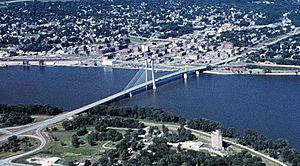
Two main roads serve Burlington: U.S. Route 34 and U.S. Route 61. U.S. Route 34 is a freeway that goes through the city.
Public Transportation
Burlington Urban Service (B.U.S.) is the city's public bus system. Its routes cover almost all of Burlington. Most residents live close to a bus stop. Burlington Trailways offers bus service to other cities from its hub in West Burlington.
Train Service
Amtrak, the national passenger train system, serves Burlington. The California Zephyr train stops here every day. It travels between Chicago, Illinois, and Emeryville, California.
Airport
The Southeast Iowa Regional Airport (BRL) is about five miles south of downtown. For bigger flights, the Quad City International Airport is about 70 miles north, in Moline, Illinois.
Famous People from Burlington
Many notable people have come from Burlington, Iowa. Here are a few:
- Dr. Wallace Carothers, who invented nylon.
- William Frawley, an actor known as Fred Mertz on the I Love Lucy show.
- Bart Howard, who wrote the famous song "Fly Me to the Moon".
- Jimmie E. Howard, a brave soldier who received the Medal of Honor. A Navy ship, the USS Howard, is named after him.
- James M. Kelly, a NASA Astronaut who flew the Space Shuttle.
- Aldo Leopold, a famous naturalist and writer.
- Arabella Mansfield, the first female lawyer in the United States.
- Robert Noyce, who helped create Intel and invented the integrated circuit (microchip).
- Charles Elliott Perkins, a railroad leader. Perkins Park in Burlington was once part of his land.
- Dr. Edward Stone, a former director of the NASA Jet Propulsion Laboratory.
- Kurt Warner, a football quarterback who was named the NFL's Most Valuable Player twice.
Sister City
Burlington has one sister city. This is a special friendship between cities in different countries.
 Barbacena, Minas Gerais, Brazil
Barbacena, Minas Gerais, Brazil
Images for kids
See also
 In Spanish: Burlington (Iowa) para niños
In Spanish: Burlington (Iowa) para niños



